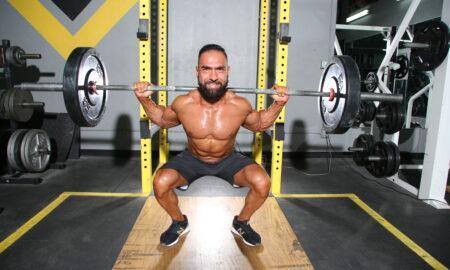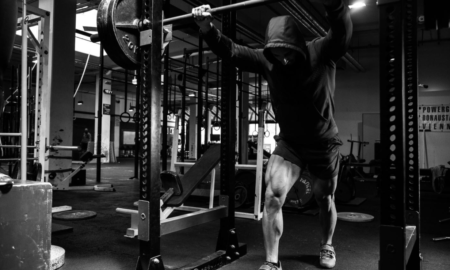To get big, you have to move heavy iron’at least on a few sets for each bodypart’and to move heavy iron, you have to be strong. So obviously, it pays big dividends to train for strength and power every so often. Unfortunately, some bodybuilders think that training for strength and power means you’re forced to neglect proportion and symmetry. Not true. You can train for both simultaneously with the POF Power Pyramid Program. It’s based on the pyramid technique, a poundage-progression method that powerlifters have been using for decades to wring as much strength-building potential out of an exercise as possible. You simply add poundage at each successive set and drop the repetition number accordingly.For example, a powerlifter’s bench press workout might look like this:
Set 1: 135 x 12
Set 2: 185 x 10
Set 3: 225 x 8
Set 4: 315 x 6
Set 5: 350 x 4
Set 6: 380 x 2
Set 7: 380 x 1-2
As a bodybuilder you want to work the three Positions of Flexion for complete development while still building plenty of strength. If, however, you use the powerlifter’s seven-set pyramid on your midrange movements and then train the other two positions’stretch and contracted’as well, you’ll drain too much of your recovery ability. Since most powerlifters don’t care about full, proportionate development, they don’t have to focus on exercises other than the three powerlifts and the assistance movements that help improve them. For bodybuilders, though, it’s much better to do a minipyramid on the big midrange exercises and follow each sequence with a stretch- and contracted-position movement for one to two sets in order to avoid doing too much work.
For example, your POF power routine for lower chest starts with bench presses for the following sets-and-reps scheme (the poundages are merely hypothetical):
Set 1: 135 x 12 (warmup)
Set 2: 155 x 10 (warmup)
Set 3: 210 x 8
Set 4: 235 x 6
Set 5: 250 x 3-4
Follow the minipyramid progression with one or two all-out sets of decline cable flyes for the stretch and contracted positions of your lower chest’and do drop sets so you get a high-rep effect. You may not realize it, but a lot of fibers are neglected when you only do low reps for a short time under tension. Drop sets’doing a set to failure and then decreasing the weight so you can get six to eight more reps’allow you to extend the tension time to 40 seconds or more, which means you attack the more endurance-oriented fibers and also stress the muscle in a unique way. The more fibers you work, the bigger you get’and we’re after the ultimate muscle-up strategy here. You want to train all aspects of each muscle, including low reps, higher reps and/or extended tension times and the three positions of flexion. You work every bodypart in a similar manner to build plenty of overall strength without neglecting proportion.
Here are a few tips for making your POF Power Pyramid Program as productive as possible:
‘Do one to two warmup sets with 50 and 75 percent of your work weight at the beginning of your pyramid. Remember that a warm muscle contracts more efficiently than a cold muscle. (Note that the program outlined on page 214 does not include warmup sets.)
‘Whenever you can get 10 reps on the first work set of your power pyramid, up the weight on all three sets at your next workout so you go back to only getting eight on your first set.
‘Go to at least positive failure on all of your sets other than warmups. If you start losing your enthusiasm, however, try a moderate-intensity week: Do four workouts without going to failure. Then on the following week go back to training with all-out intensity.
‘Feel free to use intensity techniques like 1 1/4 reps, stage sets and forced reps every so often, but don’t abuse them’never do more than seven to 10 extended sets in any one workout. If you start feeling overtrained, cut back on your intensity techniques immediately. They’ll probably work best on the stretch- and contracted-position exercises and/or the last set of your pyramid. [For more on intensity techniques, see IRONMAN’s Train, Eat, Grow, the POF muscle-training manual.]
‘Take in extra calories, but don’t get fat.
Does the POF Power Pyramid work? Here’s a letter from a bodybuilder in Fostoria, Ohio, who used it:
I’m 31 years old and started lifting weights shortly after I graduated from high school. At that time my weight was 140 at 5’10’, and in the 10 years between 1987 and ’97 I only gained 35 pounds due to improper eating and training. Then I purchased Steve Holman’s Compound Aftershock, and even though I still wasn’t eating properly, I gained 20 pounds in two years. After furthering my knowledge of Positions of Flexion, I decided to do the Power Pyramid routine because I was looking for mass and strength’and that’s exactly what I got. I went from 195 to 215 in two short months. My bench press went from 340 to 405 and my squats went from 460 to 515. I’ve never felt better, and my strength and power are unbelievable. Thank you very much for POF. Without it I might have given up. [Note: Compound Aftershock is out of print, but the Aftershock program appears in Train, Eat, Grow in its entirety.]
If you thought pyramiding was strictly for building strength, think again. Within the powerlifting ranks are some of the most massive athletes in the world, and their size is merely a side effect of their quest for ultimate strength. While it’s true that you’ll get strong when you pyramid, you’ll also build plenty of muscle, and the stretch- and contracted-position exercises, along with drop sets, will add to that size effect. If you strive for strength and power, size will follow, and incorporating POF into your program will ensure that it’s well-porportioned size you’re packing on your frame in record time.
Monday & Thursday
Quads
Midrange: Squats* 3 x 8, 6, 3-4
Stretch: Sissy squats or hack squats 1 x 8-12
Contracted: Leg extensions (drop set) 1 x 9(7)
Hamstrings
Midrange & Stretch: Stiff-legged deadlifts 2 x 8-12
Contracted: Lying leg curls (drop set) 1 x 9(7)
Calves
Midrange: Toes-pointed leg curls 1 x 12-20
Stretch: Donkey calf raises 2 x 15-20
Contracted: Standing calf raises (drop set) 1 x 12(8)
Upper chest
Midrange: Incline Smith-machine presses* 3 x 8, 6, 3-4
Stretch & Contracted: Incline cable flyes (drop set) 1 x 8(6)
Lower chest
Midrange: Barbell bench presses* 3 x 8, 6, 3-4
Stretch & Contracted: Decline cable flyes (drop set) 1 x 8(6)
Triceps
Midrange: Close-grip bench presses* 3 x 8, 6, 3-4
Stretch: Overhead extensions 1 x 8-12
Contracted: Dumbbell kickbacks (drop set) 1 x 8(6)
Tuesday & Friday
Midback
Midrange: Behind-the-neck pulldowns* 3 x 8, 6, 3-4
Stretch & Contracted: One-arm dumbbell rows 1 x 8-12
Lats
Midrange: Front pulldowns* 3 x 8, 6, 3-4
Stretch: Pullovers 1 x 8-12
Contracted: Stiff-arm pulldowns (drop set) 1 x 8(6)
Delts
Midrange: Behind-the-neck presses or dumbbell presses* 3 x 8, 6, 3-4
Stretch: Incline one-arm lateral raises 1 x 8-12
Contracted: Lateral raises or dumbbell upright rows (drop set) 1 x 8(6)
Biceps
Midrange: Barbell curls or preacher curls* 3 x 8, 6, 3-4
Stretch: Incline dumbbell curls 1 x 8-12
Contracted: Concentration curls or spider curls (drop set) 1 x 8(6)
Abs
Midrange & Lower Contracted: Kneeups 2 x 8-12
Stretch & Upper Contracted: Full-range crunches
or cable crunches with low-back support
or Ab Bench crunch pulls (drop set) 1 x 10(6)
Soleus
Contracted: Seated calf raises* 3 x 12, 10, 6-8
*Pyramid the weight: Add poundage on each successive set.
Note: This program was adapted from the book Train, Eat, Grow: The Positions-of-Flexion Muscle-Training Manual by Steve Holman.
Editor’s note: ‘The POF Power Pyramid’ was adapted from the new book Train, Eat, Grow: The Positions-of-Flexion Muscle-Training Manual. It’s available for $19.95 plus shipping. Call 1-800-447-0008. For more information see page 337 or visit www.home-gym.com. IM




















You must be logged in to post a comment Login